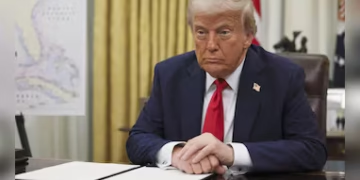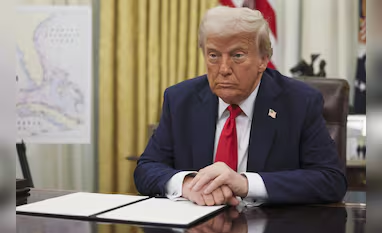In a surprising move on Wednesday, US President Donald Trump announced a 90-day suspension of his extensive tariffs on most countries, but intensified his aggressive stance against China. While many nations get a temporary reprieve, China remains at the center of the escalating trade war, with Trump imposing a staggering 125% tariffs on all Chinese goods. This move came shortly after China retaliated with a hefty 84% tariff on US imports, igniting further tension between the world’s two largest economies and creating fresh volatility in the global market.
The United States and China have been locked in a cycle of tit-for-tat tariffs for over a week, each imposing harsher duties on the other. However, after ramping up pressure on China, the White House issued a blunt warning to other global trading partners: “Do not retaliate, and you will be rewarded.” Despite this, China refused to back down and enforced its 84% tariffs on US goods at 12:01 pm on Thursday, according to state-run news agency Xinhua.
Beijing’s response to the new US tariffs was strong, with China’s Commerce Minister accusing the US of “serious infringement” on global trade. In a statement, a Ministry official emphasized that no one wins in a trade war. “China does not want a trade war, but we will not sit idly by when the legitimate rights of our people are violated,” the official stated.
Trump’s shift in policy came after financial markets experienced their most turbulent period since the early days of the COVID-19 pandemic. The market turmoil wiped out trillions of dollars and led to a sudden spike in US government bond yields, which seemed to have caught Trump’s attention.
Speaking to reporters, Trump explained his decision, saying, “People were jumping a little out of line. They were getting yippy, you know,” referring to a golf term. Despite his hardline rhetoric, the President’s unpredictable approach to tariffs has left world leaders and business executives uncertain about future US policy.
Trump had been contemplating this pause for several days, although the White House had previously dismissed reports suggesting a tariff freeze as “fake news.” Nonetheless, the reversal is not absolute. A 10% blanket tariff on nearly all US imports remains, and duties on autos, steel, and aluminum are unaffected. The freeze also does not apply to Canada and Mexico, as their goods are still subject to fentanyl-related tariffs under the US-Mexico-Canada trade agreement, unless they comply with specific origin rules.
Despite the 90-day hiatus, the day’s events highlighted the uncertainty and unpredictability of Trump’s trade policies. US Treasury Secretary Scott Bessent defended the pause, claiming it was always part of the plan to bring countries to the negotiating table. However, Trump seemed to acknowledge the financial market instability, which had played a role in his decision to reverse course. “You have to be flexible,” he said, despite insisting for days that his policies would remain unchanged.
While this shift in strategy may offer temporary relief to many nations, experts remain skeptical about China’s willingness to yield. “China is unlikely to change its strategy,” said Daniel Russel, Vice President of the Asia Society Policy Institute. “They believe that any concession to Trump would be seen as a weakness, inviting more pressure.”
Other countries may appreciate the temporary halt to the tariffs, but the constant changes in US trade policy are creating more uncertainty for businesses and governments alike. “The whiplash from constant zigzags creates more of the uncertainty that businesses and governments hate,” Russel added.
As for a potential resolution with China, Trump remains optimistic, suggesting that Beijing is eager for a deal but unsure of how to approach negotiations. “China wants to make a deal,” Trump said. “They just don’t know quite how to go about it.”















 Categories
Categories









